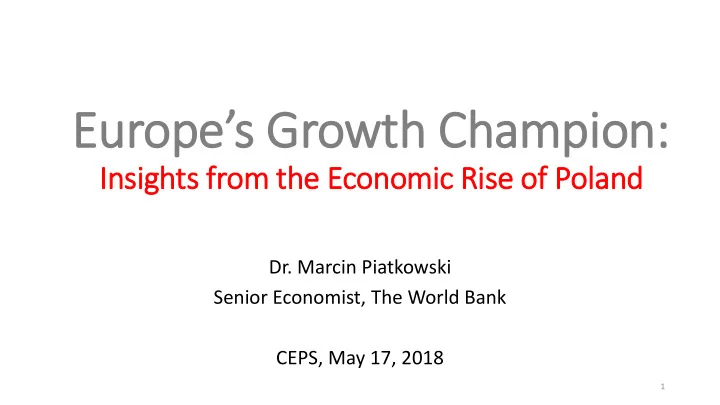

Europe’s Growth Champion: In Insights fr from the Economic Ris ise of f Poland Dr. Marcin Piatkowski Senior Economist, The World Bank CEPS, May 17, 2018 1
Motivation • Discuss why Poland (and CEE) has always been underdeveloped)=>Propose a new theory of what makes countries rich and what keeps them poor • Explain why Poland suddenly became the European and global growth champion and share lessons learned with other countries • Propose a new growth model — the Warsaw Consensus — to keep the convergence going 2
I. I. Drivers of Underdevelopment 3
Poor education 4
5 Source: Rembrandt van Rijn, “Man with a sheet of music”, 1633; “Polish Nobleman”, 1637
II. II. Towards a New Theory ry of f Development 6
Money controls the poli litical and economic systems 7 Source: Acemoglu, Johnson and Robinson, 2005
It It is difficult to get out of the ext xtractive trap • Extractive/inclusive societies are persistent and path dependent • Shifting from extractive to inclusive societies is rare • The shift mostly happens because of external shocks; inclusive internal revolutions don’t happen often • Both tend to be accompanied by violence 8
Ext xtended in institutional fr framework of f Culture, ideology, development geography individuals, luck Broad Inclusive distribution Prosperity society of income Political Economic institutions Economic Ine nequal ality Vio Violence institutions /political outcomes power Stagnation Narrow Extractive distribution society of income Worl orld 1500 15 00AD 9
Dif ifferent in institutions for growing and becoming ri rich 10
II III. . Ext xternal Shocks as Great Levelers 11
12
Human/economic disaster but a crucial legacy • Bulldozed old, extractive social and institutional structures • Industrialized the country for the first time ever • Opened up the society; ensured unprecedented social mobility, gender balance, access to education, culture 13
Unprecedented expansion in education 14
15 IV. The Unexpected Champion
16
17
18
Fastest growing economy in in Europe sin ince 1989 19
And in the world 20
Catching up on Western Europe 21
Record-breaking le length of f growth sin ince 1992 22
While keeping inequality in check 23
24 V. Drivers of Success
Proximate causes of f growth • Early reforms under communism • Deep market reforms in 1989-91 • Fast institution building • Expansion of education • Healthy banking sector • Delayed privatization, no oligarchs • Debt restructuring (1991-1994) • EU funds 25
Key le lessons fr from the transition • Speed matters: reform quickly when you can • Focus on building institutions • Do not rush privatization: haste makes waste • Invest in education • Closely supervise the banking sector • Restructure debts • Don’t overemphasize the importance of SOEs • Keep the society involved 26
Ultimate drivers of f growth • Open, broad-based, inclusive society • Strong social consensus to “return” to Europe • Growth-oriented, Westernized elites • Emergence of middle class • Western openness (EU membership) 27
28
Convergence is is li likely to continue 29 Source: own calculations based on Malinowski and van Zanden (2015), Eurostat; IMF, own projections 2020-2030
Poland’s strengths • High quality of education • Low labor costs/high productivity • Improving infrastructure • Macroeconomic stability • Good business environment • Low debt • Low corruption • Materialistic outlook, strong work ethos 30
The most competitive young generation ever! 31
In In sports too! 32
Risks • Population decline and aging • Weakening of institutions • Not fully compatible values and culture • Disintegration of the EU 33
Fast population ageing Poland: age structure in 2004 and 2050. 32.5 mln 34 Source Carone et al (2009)
VI. I. The Way Forw rward: “The Warsaw Consensus” 35
36
“The Warsaw Consensus“ “The Washington Consensus” 1. Maintain fiscal discipline 1. Strengthen institutions 2. Eliminate subsidies, fund 2. Increase savings education, health, infrastructure 3. Promote education&innovation 3. Broaden tax base, moderate 4. Boost employment rate marginal tax rates 5. Open up to immigration 4. Keep real interest rates positive 6. Keep exchange rate competitive 5. Maintain competitive exchange rate 7. Sustain strong financial supervision 6. Liberalize trade 8. Urbanize 7. Liberalize FDI 9. Keep growth inclusive 8. Privatize SOEs 10. Focus on well-being 9. Deregulate the economy 10. Safeguard property rights 38
VI. . Conclusions and Lessons Learned • Poland became Europe’s and the world’s growth champion since 1989 against many odds, after centuries of underdevelopment • Poland/CEE will not catch up with the West until it becomes a creator of ideas • Sustaining inclusive society will be key to success 39
Thank you! Email: mpiatkowski@worldbank.org Twitter: @mmpiatkowski
Recommend
More recommend